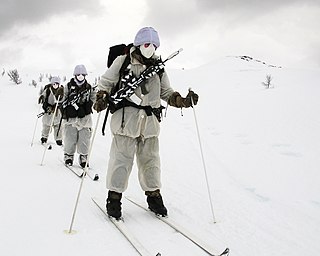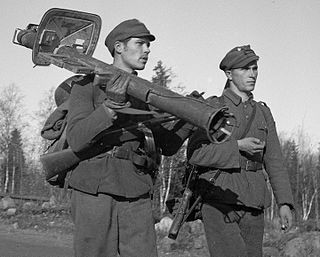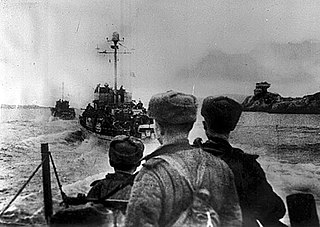Related Research Articles

A scorched-earth policy is a military strategy of destroying everything that allows an enemy military force to be able to fight a war, including the deprivation and destruction of water, food, humans, animals, plants and any kind of tools and infrastructure. Its use is possible by a retreating army to leave nothing of value worth taking, to weaken the attacking force or by an advancing army to fight against unconventional warfare.

Hjalmar Fridolf Siilasvuo was a Finnish lieutenant general, a knight of the Mannerheim Cross and a member of the Jäger Movement. He participated in the Eastern Front of World War I, the Finnish Civil War, the Winter War, Continuation War and the Lapland War.

The Finnish Army is the land forces branch of the Finnish Defence Forces. The Finnish Army is divided into six branches: the infantry, field artillery, anti-aircraft artillery, engineers, signals, and materiel troops. The commander of the Finnish Army since 1 January 2022 is Lieutenant General Pasi Välimäki.
The III Corps was a corps of the Finnish Army during the Continuation War, where Finland fought alongside Nazi Germany against the Soviet Union. Formed from the peacetime V Corps and subordinated to the German Army High Command Norway, III Corps fought initially in northern Finland on the flank of the German XXXVI Corps, participating in the Finno-German Operation Arctic Fox. In February 1944, it was moved to the Karelian Isthmus just prior to the launch of the Soviet Vyborg–Petrozavodsk offensive. Following the Moscow Armistice, III Corps took overall command of the Finnish forces participating in the Lapland War, the removal of German forces from northern Finland.

Finland participated in the Second World War initially in a defensive war against the Soviet Union, followed by another, this time offensive, war against the Soviet Union acting in concert with Nazi Germany and then finally fighting alongside the Allies against Germany.

Cold-weather warfare, also known as arctic warfare or winter warfare, encompasses military operations affected by snow, ice, thawing conditions, or cold, both on land and at sea, as well as the strategies and tactics used by military forces in these situations and environments.

Lothar Rendulic was an Austrian army group commander in the Wehrmacht during World War II. Rendulic was one of three Austrians who rose to the rank of Generaloberst in the German armed forces. The other two were Romanian-born Alexander Löhr and Erhard Raus from Moravia.

The Battle of Tornio was the first major engagement between Nazi Germany and Finland in the Lapland War; although hostilities had already begun elsewhere.

The Petsamo–Kirkenes offensive was a major military offensive during World War II, mounted by the Red Army against the Wehrmacht in 1944 in the Petsamo region, ceded to the Soviet Union by Finland in accordance with the Moscow Armistice, and Norway. The offensive defeated the Wehrmacht's forces in the Arctic, driving them back into Norway, and was called the "Tenth Shock" by Stalin. It later expelled German forces from the northern part of Norway and seized the nickel mines of Petsamo.

The Battle of Rovaniemi was an event during the 1944 Lapland War. The actual fighting between the components of the Finnish Armoured Division and Finnish 3rd Division against the troops of the German Twentieth Mountain Army took place at the vicinity of the town of Rovaniemi. The notoriety of the encounter derives from the near-total destruction of the town.
The 14th Army was a field army of the Soviet Army, formed twice.

In Operation Doomsday, the British 1st Airborne Division acted as a police and military force during the Allied occupation of Norway in May 1945, immediately after the victory in Europe during the Second World War. The division maintained law and order until the arrival of the remainder of Force 134, the occupation force. During its time in Norway, the division was tasked with supervising the surrender of the German forces in Norway, as well as preventing the sabotage of vital military and civilian facilities.

During World War II, the Lapland War saw fighting between Finland and Nazi Germany – effectively from September to November 1944 – in Finland's northernmost region, Lapland. Though the Finns and the Germans had been fighting together against the Soviet Union since 1941 during the Continuation War (1941–1944), peace negotiations between the Finnish government and the Allies of World War II had been conducted intermittently during 1943–1944, but no agreement had been reached. The Moscow Armistice, signed on 19 September 1944, demanded that Finland break diplomatic ties with Germany and expel or disarm any German soldiers remaining in Finland.
Operation Birke was a German operation late in World War II in Finnish Lapland to protect access to nickel.

The Liberation of Finnmark was an Allied military operation lasting from 23 October 1944 until 26 April 1945, in which Soviet and Norwegian forces wrested away control of Finnmark, the northernmost county of Norway, from Germany. It began with a Soviet offensive that liberated Kirkenes.

The following events occurred in October 1944:

The Battle of Olhava occurred during the Lapland War on 28 September 1944. A brief armed struggle occurred in Northern Finland between retreating German troops and north of the advancement of the Finnish troops. The previous day the first skirmish between German and Finnish troops in Pudasjärvi. In Olhava, troops for the first time opened full-scale fire against each other and the casualties were the first of the Lapland War.
The 367th Rifle Division was raised in 1941 as a standard Red Army rifle division, and served for the duration of the Great Patriotic War in that role. It began forming in August 1941 in the Chelyabinsk Oblast. After forming, it was initially assigned to the 28th (Reserve) Army, but was soon reassigned to Karelian Front, where it remained until nearly the end of 1944. The division had mostly a relatively quiet war on this defensive front, but later saw action against the German forces trying to hold northern Finland, being awarded the Order of the Red Banner for its services. The division ended the war in 14th Separate Army on garrison duties in the far north.
References
- ↑ Ahto, Sampo (1980). Aseveljet vastakkain - Lapin sota 1944-1945[Brothers in arms against each other - Lapland War 1944-1945] (in Finnish). Helsinki: Kirjayhtymä. pp. 92–99. ISBN 951-26-1726-9.
- ↑ Carruthers, Bob (2012). Hitler's Forgotten Armies: Combat in Norway and Finland. Warwickshire: Coda Books Ltd. ISBN 9781781580981.
- ↑ Hunt, Vincent (2014). Fire and Ice. Stroud, Gloucestershire: The History Press. ISBN 9780750956369.